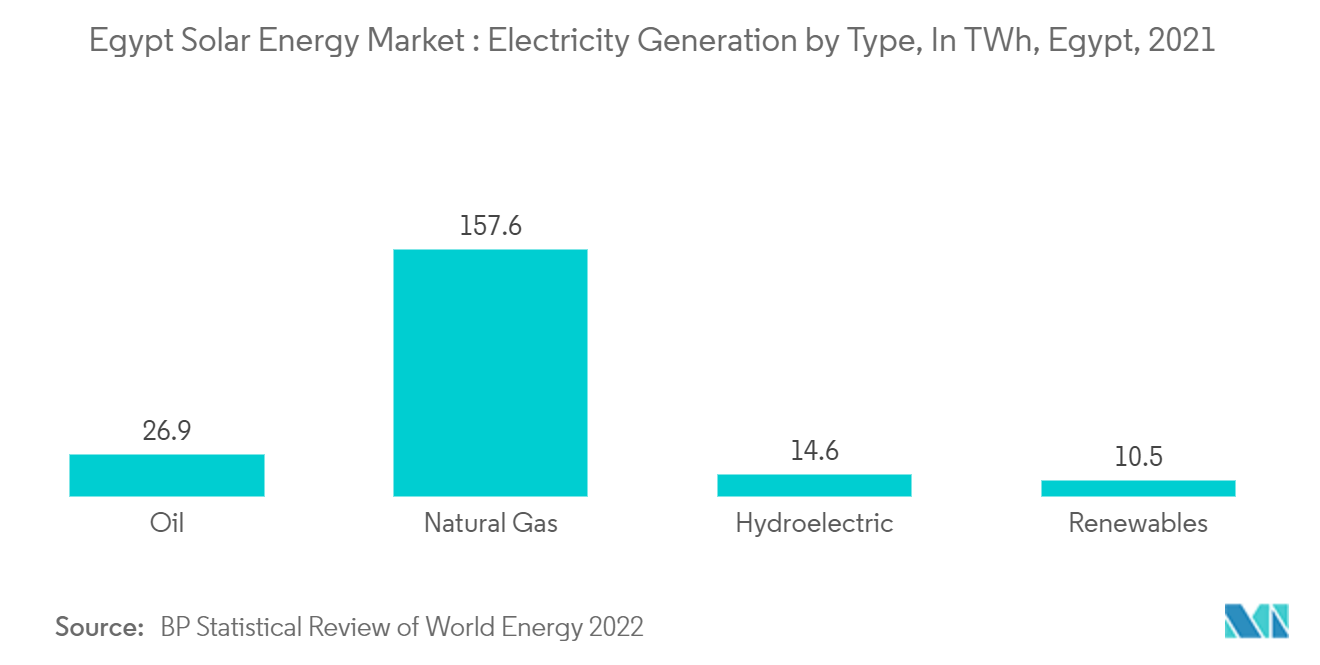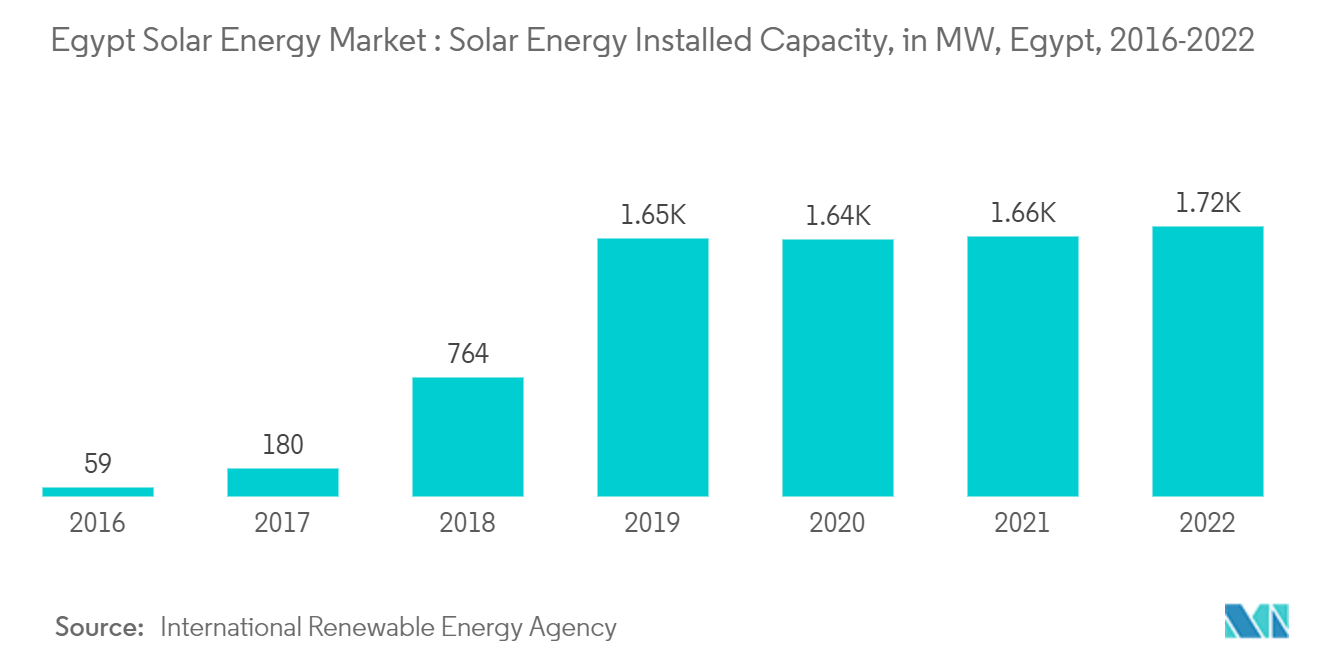Market Trends of Egypt Solar Energy Industry
On-Grid Technology to Dominate the Market
- Egypt has connected a large capacity of solar energy to the grid over the past few years. Most of this capacity comes from large-scale ground-mounted projects, such as the 1.4 GW Benban Solar Park. However, many grid-connected small-scale solar system projects have also been connected to the grid during the same time, increasing the on-grid solar capacity.
- In Egypt, the New and Renewable Energy Authority (NREA) collaborates with the National Project Grid-Connected Small-Scale Photovoltaic Systems (Egypt-PV) to promote the design and implementation of small-scale solar systems with capacities less than 500 kilowatts, create replicable models, in addition to providing technical and financial support for these projects, and support the development of the solar PV market in Egypt. The Global Environment Facility (GEF) is funding the Industrial Modernization Center's (IMC) implementation of the Egypt PV project in collaboration with the United Nations Development Program (UNDP).
- Egypt PV has already provided technical and financial assistance for about 150 pilot PV projects in various sectors, such as industrial, educational, commercial, public, tourism, and residential. Of these, 123 solar PV projects with capacities between 5 and 500 kW were completed across Egypt, with many other projects currently underway. According to NREA, these projects have led to annual power savings of nearly 14.8 GWh.
- The government has developed a 2035 Integrated Sustainable Energy Strategy, which emphasizes the importance of renewable energy in the country. Egypt's government aims to increase the electricity supply generated from renewable sources to 42% by 2035. With a significant focus on photovoltaic energy providing 21.3%, wind providing 14%, hydropower at 1.98%, concentrating solar power at 5.52%, and conventional energy sources at 57.33% by 2035. In 2012, the solar energy production capacity was 15 MW, and in 2021 it reached 1,655 MW.
- Under this project, many PV systems were implemented in various capacities. PV systems have been installed across six different hotels to meet their consumption needs in several governorates across Egypt, including Cairo, South Sinai, and the Red Sea. PV systems have also been deployed in the educational sector, and pilot models were implemented in two international and two national schools located in New Cairo on October 6 in the cities of Giza and Cairo.
- Owing to the above point, on-grid is expected to drive the market during the forecast period.

Supportive Government Policies and Initiatives Driving the Market Demand
- The Egyptian government's support in the form of advantageous incentives and policies has been one of the main factors contributing to the rapid growth of the Egyptian solar market. The government formulated plans under its National Renewable Energy Strategy to increase the share of renewable energy in the national energy mix to 20% by 2022 and further double it to 42% by 2035. To achieve these goals, the government has also been regularly updating its solar energy policy to maximize the growth of the sector according to market conditions. Egyptian government agencies have also been actively involved in the adoption and commercialization of smaller solar PV systems for residential, commercial, and industrial customers.
- In March 2022, the Egyptian Electricity Utility & Consumer Protection Regulatory Agency (Egyptera) approved new incentives for net metering and self-consumption solar power systems to support utility-scale solar project developers. These incentives were approved as a part of an effort to encourage investments in the renewable energy sector ahead of COP27 in November 2022.
- According to the new incentives, Egyptera has decided to entirely remove the cap on the amount of solar energy private-sector players can generate under net metering, which had restricted installed solar capacity per distribution company to 1.5% of the company's maximum distribution capacity during the previous fiscal year.
- The new amendments have also raised the limit on the aggregate capacity of all developers across the country under the net metering scheme from 300 MW previously to 1 GW. Additionally, the ministry has also decided to raise the cutoff capacity for projects obliged to pay integration fees from 500 kW to 1 MW. Project developers developing projects with capacities in excess of 1 MW have to pay an integration fee of EGP 0.257-0.329 per KWh to help defray the costs of connecting to the national grid.
- For small-scale consumers, Egypt's New and Renewable Energy Authority (NREA) has created the National Project Grid-Connected Small-Scale Photovoltaic Systems (Egypt-PV) to promote the design and implementation of small-scale solar systems with capacities less than 500 kW. The program consists of the creation of replicable models, providing technical and financial support for such projects, and supporting the development of the solar PV market in Egypt.
- The Global Environment Facility (GEF) is funding the Industrial Modernization Center's (IMC) implementation of the Egypt PV project in collaboration with the United Nations Development Program (UNDP). Overall, the project has provided technical and financial support for a total capacity of about 10 MW, with total investments amounting to EGP 140 million, of which EGP 19 million are non-refundable grants.
- Egypt PV has already provided technical and financial assistance for about 150 pilot PV projects in various sectors, such as industrial, educational, commercial, public, tourism, and residential. In 2020, 123 solar PV projects with capacities between 5 and 500 kW were completed across Egypt, with many other projects in progress. According to NREA, these projects have led to annual power savings of nearly 14.8 GWh.
- A constant updating of market policies according to the market environment and supportive government policies and incentives for both small-scale and utility-scale solar project owners, such as the Egypt-PV program, are expected to provide a considerable impetus to the Egypt Solar Market during the forecast period.

